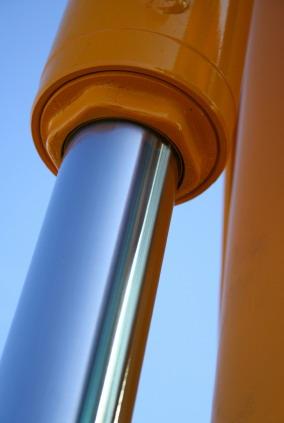
Sixty percent of the oils within biodegradable hydraulic fluids must convert to carbon dioxide within 28 days for the oil industry to consider them "readily biodegradable." All substances, including petrol-based ones, ultimately will degrade. This means that living organisms within the environment will transform them into carbon dioxide and water. The question to consider is how long the conversion takes, and that ranges from moments to centuries. The oil industry refers to oils that degrade 20 to 60 percent in 28 days as "inherently biodegradable."
Defining Hydraulic Systems
The Merriam-Webster dictionary defines hydraulics as "the transfer of energy through a liquid in motion." If you have ever filled a balloon with water and squeezed one end, pushing the water to the other end, you have created a hydraulic system. This simple concept, in use since the seventeenth century, is the driving force behind some of today's most complex machinery. Everything from seats in movie theaters to manned space flights utilize hydraulic applications.
Hydraulic Fluids
Water, oil and occasionally gas are capable of powering hydraulic systems. Water was used for centuries, but petrol-based oils became the predominant hydraulic fluids of the 20th century for a variety of reasons:
- Oil is not easily compressed
- It is a good conductor of heat
- It is fluid at low temperatures
- It controls corrosion
Problems with Petrol-based Hydraulic Fluids
Petrol-based hydraulic fluids do not degrade readily, and that is a problem because:
- Hydraulic systems sometimes leak fluid
- Spills happen despite operators' best efforts to prevent them
- Hydraulic equipment using petrol-based fluids must be cleaned with strong detergents
All these things contribute to the pollution of groundwater and have the potential to pose serious health risks. Responding to these concerns paved the way for the development of plant-based hydraulic fluids.
Readily Biodegradable Hydraulic Fluid
No particular date or invention defines a conversion from petrol-based to plant-based biodegradable hydraulic fluids. Developing and introducing these fluids is more of an evolution with a variety of milestones.
Extracting Estolides
Estolides are fatty acids that typically come from petrol, and they are the chemical building blocks for most hydraulic fluids. Scientists learned to extract estolides from soybean oil and meadowfoam, a plant that grows in the Northwestern United States and is commonly used in cosmetics.
Scientists feared extracting high-quality estolides in adequately high quantities could prove difficult, but they soon learned that plant oils high in oleic acid yield the best results. High-oleic oils are also used in to produce some foods and may help lower blood cholesterol in humans. Multiple mainstream demands for a plant, or its derivatives, encourage farmers to grow that crop, making the resource more readily available.
Testing for Biodegradability
Tests indicate that 80 percent of plant-based hydraulic fluid degrades in 28 days, putting it well over the mark to be considered readily biodegradable. This compares to only a 30 percent degradation in petrol-based oils.
Refining the Performance of Plant-based Hydraulic Fuels
Oil companies compete tirelessly to bring to market the best performing hydraulic fluids. Some of their goals include:
- Stable viscosity, which allows the fluid to be used in a broader range of temperatures and conditions
- Minimal oxidation
- Complete biodegradation
- Enhanced lubrication
- Reduced demulsification
- Resistance to fire
Government Regulation of Hydraulic Fluids
The U.S. Government does not regulate the kinds of fluids you put into your hydraulics equipment. If there is a spill, however, the government cares a great deal about what comes out of your equipment. Fines for spilling hazardous waste are steep.
CERCLA
The Comprehensive Environmental Response, Compensation, and Liability Act (CERCLA), passed in 1986, established a Superfund to clean up hazardous waste. It also grants authority to the Environmental Protection Agency (EPA) in all 50 states to seek out those responsible for hazardous waste pollution and hold them accountable.
Spilling Hydraulic Fluid
If you spill hydraulic fluid, biodegradable or not, you must report the spill to the U.S. Coast Guard. It staffs the National Response Center for the EPA. A representative will visit your site and collect a sample for analysis. The level of toxicity revealed by the analysis determines whether you must pay a fine and how much the cost will be. Using plant-based hydraulic fluid may save you tens of thousands of dollars in case of a spill.
Be aware that the fluid you put into your hydraulic system may not be the same fluid that comes out. With heavy use metals leach from the machine and into the fluid, causing contamination. Also be aware that additives and even residue from flushing solutions may not readily degrade.
Owners of hydraulic equipment are often torn between doing what is best for the environment and doing what is best for their businesses. Plant-based hydraulic fluid will we widely adopted only when its price drops and its quality rises enough to compete effectively with petrol-based fluids.







